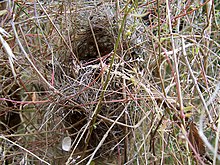
Nesting behavior refers to an instinct in animals during reproduction to prepare a place with optimal conditions for offspring.[1] The nesting place provides protection against predators and competitors that mean to exploit or kill offspring.[2] It also provides protection against the physical environment.[1]
Nest building is important in family structure[3] and is therefore influenced by different mating behaviours and social settings.[4] It is found in a variety of animals such as birds, fish, mammals, amphibians, and reptiles.[1]
- ^ a b c Baden, Andrea L. (2019-01-01). "A description of nesting behaviors, including factors impacting nest site selection, in black‐and‐white ruffed lemurs (Varecia variegata)". Ecology and Evolution. 9 (3): 1010–1028. doi:10.1002/ece3.4735. ISSN 2045-7758. PMC 6374655. PMID 30805137.
- ^ Lewarch, Caitlin L.; Hoekstra, Hopi E. (2018-05-01). "The evolution of nesting behaviour in Peromyscus mice". Animal Behaviour. 139: 103–115. doi:10.1016/j.anbehav.2018.03.008. ISSN 0003-3472.
- ^ Torres-Lista, Virginia (15 June 2013). "Impairment of nesting behaviour in 3xTg-AD mice". Behavioural Brain Research. 247: 153–157. doi:10.1016/j.bbr.2013.03.021. PMID 23523959. S2CID 24496866.
- ^ Lewarch, Caitlin L.; Hoekstra, Hopi E. (2018-05-01). "The evolution of nesting behaviour in Peromyscus mice". Animal Behaviour. 139: 103–115. doi:10.1016/j.anbehav.2018.03.008. ISSN 0003-3472.
© MMXXIII Rich X Search. We shall prevail. All rights reserved. Rich X Search
